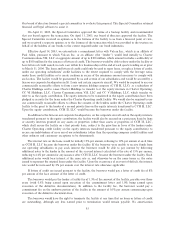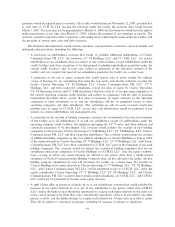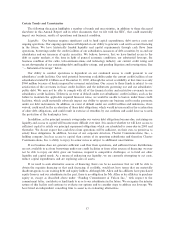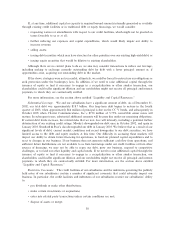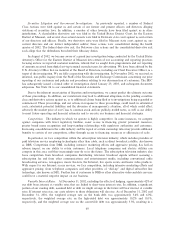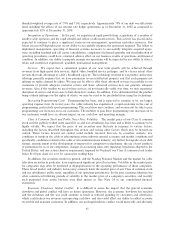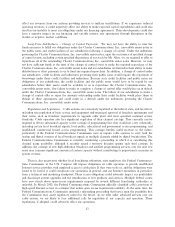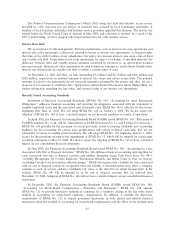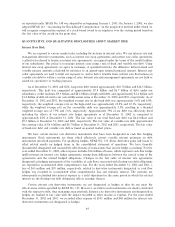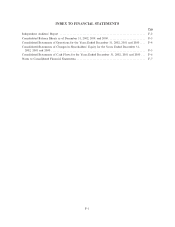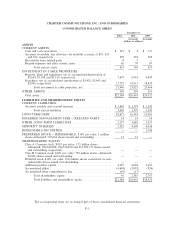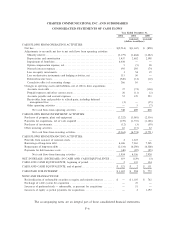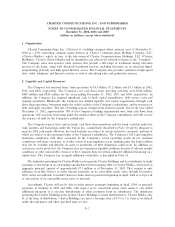Charter 2002 Annual Report Download - page 65
Download and view the complete annual report
Please find page 65 of the 2002 Charter annual report below. You can navigate through the pages in the report by either clicking on the pages listed below, or by using the keyword search tool below to find specific information within the annual report.The Federal Communications Commission's March 2002 ruling also held that Internet access service
provided by cable operators was not subject to franchise fees assessed by local franchising authorities. A
number of local franchise authorities and Internet service providers appealed this decision. The matter was
argued before the Ninth Circuit Court of Appeals in May 2003, and a decision is awaited. As a result of the
FCC's initial ruling, we have stopped collecting franchise fees for cable modem service.
Interest Rate Risk
We use interest rate risk management derivative instruments, such as interest rate swap agreements and
interest rate collar agreements (collectively referred to herein as interest rate agreements) as required under
the terms of the credit facilities of our subsidiaries. Our policy is to manage interest costs using a mix of Ñxed
and variable rate debt. Using interest rate swap agreements, we agree to exchange, at speciÑed intervals, the
diÅerence between Ñxed and variable interest amounts calculated by reference to an agreed-upon notional
principal amount. Interest rate collar agreements are used to limit our exposure to, and to derive beneÑts from,
interest rate Öuctuations on variable rate debt to within a certain range of rates.
At December 31, 2002 and 2001, we had outstanding $3.4 billion and $3.3 billion and $520 million and
$520 million, respectively, in notional amounts of interest rate swaps and collars, respectively. The notional
amounts of interest rate instruments do not represent amounts exchanged by the parties and, thus, are not a
measure of our exposure to credit loss. See ""Quantitative and Qualitative Disclosures About Market Risk'' for
further information regarding the fair values and contract terms of our interest rate agreements.
Recently Issued Accounting Standards
Statement of Financial Accounting Standards (SFAS) No. 143, ""Accounting for Asset Retirement
Obligations,'' addresses Ñnancial accounting and reporting for obligations associated with the retirement of
tangible long-lived assets and the associated asset retirement costs. SFAS No. 143 is eÅective for Ñscal years
beginning after June 15, 2002. We will adopt SFAS No. 143 on January 1, 2003. We do not expect the
adoption of SFAS No. 143 to have a material impact on our Ñnancial condition or results of operations.
In April 2002, the Financial Accounting Standards Board (FASB) issued SFAS No. 145, ""Rescission of
FASB Statements No. 4, 44, and 64, Amendment of FASB Statement No. 13, and Technical Corrections.''
SFAS No. 145 provides for the rescission of several previously issued accounting standards, new accounting
guidance for the accounting for certain lease modiÑcations and various technical corrections that are not
substantive in nature to existing pronouncements. We will adopt SFAS No. 145 beginning January 1, 2003,
except for the provisions relating to the amendment of SFAS No. 13, which will be adopted for transactions
occurring subsequent to May 15, 2002. We do not expect the adoption of SFAS No. 145 to have a material
impact on our consolidated Ñnancial statements.
In June 2002, the Financial Accounting Standards Board issued SFAS No. 146, ""Accounting for Costs
Associated with Exit or Disposal Activities.'' SFAS No. 146 addresses Ñnancial accounting and reporting for
costs associated with exit or disposal activities and nulliÑes Emerging Issues Task Force Issue No. 94-3,
""Liability Recognition for Certain Employee Termination BeneÑts and Other Costs to Exit an Activity
(including Certain Costs Incurred in a Restructuring).'' SFAS 146 requires that a liability for costs associated
with an exit or disposal activity be recognized when the liability is incurred rather than when a company
commits to such an activity and also establishes fair value as the objective for initial measurement of the
liability. SFAS No. 146 will be adopted by us for exit or disposal activities that are initiated after
December 31, 2002. Adoption of SFAS No. 146 will not have a material impact on our consolidated Ñnancial
statements.
In December 2002, the Financial Accounting Standards Board (FASB) issued SFAS No. 148,
""Accounting for Stock-Based Compensation Ì Transition and Disclosure.'' SFAS No. 148 amends
SFAS No. 123 to provide alternative methods of transition for a voluntary change to the fair value based
method of accounting for stock-based employee compensation. In addition, it amends the disclosure
requirements of SFAS No. 123 to require prominent disclosures in both annual and interim Ñnancial
statements about the method of accounting for stock-based compensation and the eÅect of the method used
63


